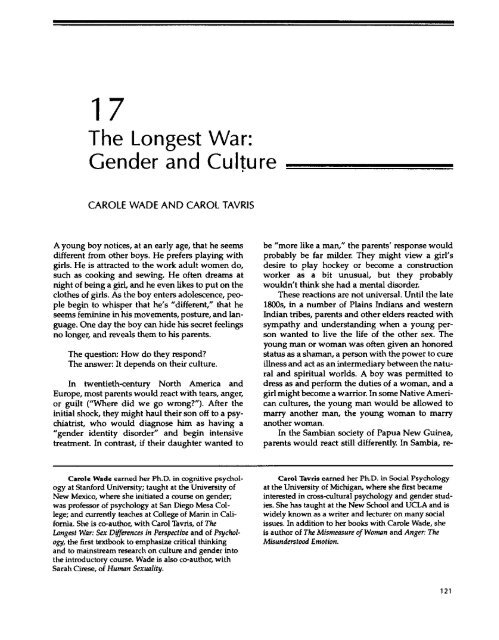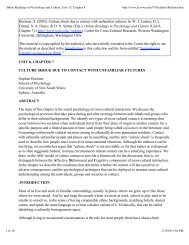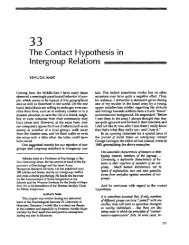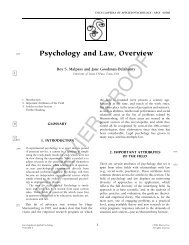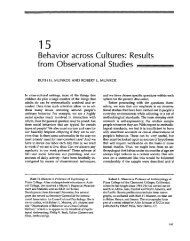The Longest War: Gender and Culture
The Longest War: Gender and Culture
The Longest War: Gender and Culture
Create successful ePaper yourself
Turn your PDF publications into a flip-book with our unique Google optimized e-Paper software.
<strong>The</strong> <strong>Longest</strong> <strong>War</strong>:<br />
<strong>Gender</strong> <strong>and</strong> <strong>Culture</strong><br />
CAROLE WADE AND CAROL TAVRIS<br />
A young boy notices, at an early age, that he seems<br />
different from other boys. He prefers playing with<br />
girls. He is attracted to the work adult women do,<br />
such as cooking <strong>and</strong> sewing. He often dreams at<br />
night of being a girl, <strong>and</strong> he even likes to put on the<br />
clothes of girls. As the boy enters adolescence, people<br />
begin to whisper that he's "different," that he<br />
seems feminine in his movements, posture, <strong>and</strong> language.<br />
One day the boy can hide his secret feelings<br />
no longer, <strong>and</strong> reveals them to his parents.<br />
<strong>The</strong> question: How do they respond<br />
<strong>The</strong> answer: It depends on their culture.<br />
In twentieth-century North America <strong>and</strong><br />
Europe, most parents would react with tears, anger,<br />
or guilt ("Where did we go wrong"). After the<br />
initial shock, they might haul their son off to a psychiatrist,<br />
who would diagnose him as having a<br />
"gender identity disorder" <strong>and</strong> begin intensive<br />
treatment. In contrast, if their daughter wanted to<br />
be "more like a man," the parents' response would<br />
probably be far milder. <strong>The</strong>y might view a girl's<br />
desire to play hockey or become a construction<br />
worker as a bit unusual, but they probably<br />
wouldn't think she had a mental disorder.<br />
<strong>The</strong>se reactions are not universal. Until the late<br />
1800s, in a number of Plains Indians <strong>and</strong> western<br />
Indian tribes, parents <strong>and</strong> other elders reacted with<br />
sympathy <strong>and</strong> underst<strong>and</strong>ing when a young person<br />
wanted to live the life of the other sex. <strong>The</strong><br />
young man or woman was often given an honored<br />
status as a shaman, a person with the power to cure<br />
illness <strong>and</strong> act as an intermediary between the natural<br />
<strong>and</strong> spiritual worlds. A boy was permitted to<br />
dress as <strong>and</strong> perform the duties of a woman, <strong>and</strong> a<br />
girl might become a warrior. In some Native American<br />
cultures, the young man would be allowed to<br />
marry another man, the young woman to marry<br />
another woman.<br />
In the Sambian society of Papua New Guinea,<br />
parents would react still differently. In Sambia, re-<br />
Carole Wade earned her Ph.D. in cognitive psychology<br />
at Stanford University; taught at the University of<br />
New Mexico, where she initiated a course on gender;<br />
was professor of psychology at San Diego Mesa College;<br />
<strong>and</strong> currently teaches at College of Marin in California.<br />
She is co-author, with Carol Tavris, of <strong>The</strong><br />
<strong>Longest</strong> <strong>War</strong>: Sex Differences in Perspective <strong>and</strong> of Psychology,<br />
the first textbook to emphasize critical thinking<br />
<strong>and</strong> to mainstream research on culture <strong>and</strong> gender into<br />
the introductory course. Wade is also co-author, with<br />
Sarah Cirese, of Human Sexuality.<br />
Carol Tavris earned her Ph.D. in Social Psychology<br />
at the University of Michigan, where she first became<br />
interested in cross-cultural psychology <strong>and</strong> gender studies.<br />
She has taught at the New School <strong>and</strong> UCLA <strong>and</strong> is<br />
widely known as a writer <strong>and</strong> lecturer on many social<br />
issues. In addition to her books with Carole Wade, she<br />
is author of <strong>The</strong> Mismeasure of Woman <strong>and</strong> Anger: <strong>The</strong><br />
Misunderstood Emotion.
122 17/ <strong>The</strong> <strong>Longest</strong> <strong>War</strong>: <strong>Gender</strong> <strong>and</strong> <strong>Culture</strong><br />
ports anthropologist Gilbert Herdt (1984), all adolescent<br />
boys are required to engage in oral sex with<br />
older men as part of their initiation into manhood.<br />
Sambians believe that a boy cannot mature physically<br />
or emotionally unless he ingests another<br />
man's semen over a period of several years. However,<br />
Sambian parents would react with shock <strong>and</strong><br />
disbelief if a son said he wanted to live as a woman.<br />
Every man <strong>and</strong> woman in Sambian society marries<br />
someone of the other sex <strong>and</strong> performs the work<br />
assigned to his or her own sex; no exceptions.<br />
What these diverse reactions tell us is that although<br />
anatomical sex is universal <strong>and</strong> unchangeable<br />
(unless extraordinary surgical procedures are<br />
used), gender, which encompasses all the duties,<br />
rights, <strong>and</strong> behaviors a culture considers appropriate<br />
for males <strong>and</strong> females, is a social invention. It is<br />
gender, not anatomical sex, that gives us a sense of<br />
personal identity as male or female. <strong>Culture</strong>s have<br />
different notions about what gender roles should<br />
entail, how flexible these roles ought to be, <strong>and</strong> how<br />
much leeway males <strong>and</strong> females have to cross the<br />
gender divide.<br />
Perhaps, however, there is something essential<br />
about the sexes, something lying beneath the veneer<br />
of culture, immutable <strong>and</strong> eternal. That assumption<br />
is certainly widespread, <strong>and</strong> it has guided the research<br />
of social scientists as well as the beliefs of<br />
laypersons. Let us examine this assumption more<br />
closely. Are there some aspects of masculinity <strong>and</strong><br />
femininity that occur at all times <strong>and</strong> in all places<br />
If certain characteristics are common, why is that<br />
so What determines how men <strong>and</strong> women should<br />
act toward each other, what their rights <strong>and</strong> obligations<br />
should be, <strong>and</strong> what it means, in psychological<br />
terms, to be female or male<br />
SEARCHING FOR THE<br />
ESSENTIAL MAN<br />
AND WOMAN<br />
By comparing <strong>and</strong> contrasting different cultures<br />
around the world, social scientists have tried to<br />
identify those aspects of gender that are universally<br />
male or female. <strong>The</strong>ir efforts may sound pretty<br />
straightforward. However, because researchers, like<br />
everyone else, are influenced by their own deeply<br />
felt perceptions <strong>and</strong> convictions about gender, the<br />
topic has been one of the most complex to study<br />
cross-culturally<br />
For many years American <strong>and</strong> European researchers<br />
looked for <strong>and</strong> found evidence that pri-<br />
mate males (human <strong>and</strong> ape) were "by nature"<br />
competitive, dominant, <strong>and</strong> promiscuous, whereas<br />
primate females were "by nature" cooperative, submissive,<br />
<strong>and</strong> monogamous (Tavris, 1992). Because<br />
of their own preconceptions about male <strong>and</strong> female<br />
roles, based on their own cultural experiences,<br />
these observers often overlooked the evidence that<br />
contradicted their assumptions, even when the widence<br />
was in front of their noses.<br />
For example, many years ago the famous anthropologist<br />
Bronislaw Malinowski wrote a book<br />
on the Tmbri<strong>and</strong> Isl<strong>and</strong>ers, in which he concluded<br />
that males controlled the economic <strong>and</strong> political life<br />
of the community. (Another of his biases is glaringly<br />
apparent in the title he gave his book: <strong>The</strong><br />
Sexual Life of Savages.) But when Annette Weiner<br />
went to live among the Trobri<strong>and</strong>ers many years<br />
later, she learned, by talking to the women, what<br />
Malinowski had not: that there was an important<br />
economic underground controlled by the labor <strong>and</strong><br />
exchanges of women.<br />
Similarly, in 1951, another famous anthropologist,<br />
E. E. Evans-Pritchard, reported that among the<br />
Nuer, a tribe living in the Sudan, husb<strong>and</strong>s had<br />
unchallenged authority over their wives. Yet he<br />
himself described incidents in Nuer family life that<br />
contradicted his conclusion:<br />
[Should a Nuer wife1 in a quurrel with her husb<strong>and</strong><br />
disfigure him-knock a tooth out, for example-herfather<br />
must pay him compensation.<br />
I have myself on two occasions seen a father pay<br />
a heifer to his son-in-law to atone for insults<br />
hurled at the husb<strong>and</strong>'s head by his wife when<br />
irritated by accusations of adultery.<br />
We don't approve of domestic violence, nor do we<br />
think the wife's actions cancel out men's political<br />
power over women in Nuer culture. However, as<br />
anthropologist Micaela di Leonardo observes, a<br />
husb<strong>and</strong>'s authority in the home is not absolute if<br />
his wife can insult him <strong>and</strong> knock his teeth out, <strong>and</strong><br />
all he can do is dem<strong>and</strong> that his father-in-law fork<br />
over a cow!<br />
Many early researchers not only assumed that<br />
male dominance <strong>and</strong> aggression were universally<br />
the province of men; they also assumed that female<br />
nurturance was universally the province of women.<br />
Because of this assumption, Western researchers<br />
often overlooked the nurturing activities of men, or<br />
even defined nurturance in a way that excluded the<br />
altruistic, caring actions of men. When anthropologist<br />
David Gilmore (1991) examined how cultures
17/ <strong>The</strong> <strong>Longest</strong> <strong>War</strong>: <strong>Gender</strong> <strong>and</strong> <strong>Culture</strong> 123<br />
around the world define manhood, he expected to<br />
find masculinity equated with selfishness <strong>and</strong> hardness.<br />
Instead he found that it often entails selfless<br />
generosity <strong>and</strong> sacrifice. "Women nurture others directly,"<br />
notes Gilmore. "<strong>The</strong>y do this with their bodies,<br />
with their milk <strong>and</strong> their love. This is very<br />
sacrificial <strong>and</strong> generous. But surprisingly, 'real' men<br />
nurture, too, although they would perhaps not be<br />
pleased to hear it put this way." Men nurture their<br />
families <strong>and</strong> society, he observes, by "bringing<br />
home food for both child <strong>and</strong> mother. . . <strong>and</strong> by<br />
dying if necessary in faraway places to provide a<br />
safe haven for their people." (pp. 229-230)<br />
Our own cultural stereotypes, then, affect what<br />
we see in other cultures <strong>and</strong> how we interpret what<br />
we see. Still, a few common themes-not universal,<br />
mind you, but common40 emerge from the crosscultural<br />
study of gender. Generally speaking, men<br />
have had, <strong>and</strong> continue to have, more status <strong>and</strong><br />
more power than women, especially in public affairs.<br />
Generally speaking, men have fought the<br />
wars <strong>and</strong> brought home the meat. If a society's<br />
economy includes hunting large game, traveling a<br />
long way from home, or making weapons, men<br />
typically h<strong>and</strong>le these activities. Women have had<br />
the primary responsibility for cooking, cleaning,<br />
<strong>and</strong> taking care of small children.<br />
Corresponding with this division of jobs, in<br />
many cultures around the world people regard<br />
masculinity as something that boys must achieve<br />
through strenuous effort. Males must pass physical<br />
tests, must endure pain, must confront danger, <strong>and</strong><br />
must separate psychologically <strong>and</strong> even physically<br />
from their mothers <strong>and</strong> the world of women. Sometimes<br />
they have to prove their self-reliance <strong>and</strong><br />
courage in bloodcurdling initiation rites. Femininity,<br />
in contrast, tends to be associated with responsibility,<br />
obedience, <strong>and</strong> childcare, <strong>and</strong> it is seen as<br />
something that develops naturally, without any<br />
special intervention from others.<br />
THE INVENTION OF GENDER<br />
From these commonalities, some theorists have<br />
concluded that certain fundamental aspects of gender<br />
must be built into our genes. Biological factors-the<br />
fact that women are (so far) the only sex<br />
that gets pregnant <strong>and</strong> that men, on the average,<br />
have greater upper body strength-undoubtedly<br />
play some role in the sexual division of labor in<br />
many societies. But biology takes us only so far,<br />
because, when we remove our own cultural blid-<br />
ers <strong>and</strong> look at the full cross-cultural picture, the<br />
range of variation among men <strong>and</strong> women, in what<br />
they do <strong>and</strong> in how they regard one another, is<br />
simply astonishing.<br />
For instance, in some places women are <strong>and</strong><br />
have been completely under the rule of men, an<br />
experience reflected in the haunting words of the<br />
Chinese poet Fu Hsuan: "How sad it is to be a<br />
woman! Nothing on earth is held so cheap."<br />
Women in Saudi Arabia today are not allowed to<br />
drive a car; many girls in India submit to arranged<br />
marriages as early as age nine; girls <strong>and</strong> women in<br />
the Sudan <strong>and</strong> other parts of Africa are subjected to<br />
But biology takes us only so far,<br />
because, when we remove our<br />
own cultural blinders <strong>and</strong> look at<br />
the full cross-cultural picture, the<br />
range of variation among men <strong>and</strong><br />
women, in what they do <strong>and</strong> in<br />
how they regard one another, is<br />
simply astonishing.<br />
infibulation (the practice of cutting off the clitoris<br />
<strong>and</strong> much of the labia, <strong>and</strong> stitching together the<br />
vaginal opening), allegedly to assure their virginity<br />
at marriage. Yet elsewhere women have achieved<br />
considerable power, influence, <strong>and</strong> sexual independence.<br />
Among the Iroquois, some of the older<br />
wives played an important role in village politics.<br />
Although they could not become members of the<br />
Council of Elders, the ruling body, they had a major<br />
say in its decisions. In this century, women have<br />
been heads of state in Engl<strong>and</strong>, Israel, India, Sri<br />
Lanka, Icel<strong>and</strong>, <strong>and</strong> elsewhere.<br />
Thus it is an oversimplification to say that men<br />
are the dominant sex, women the subordinate one.<br />
<strong>The</strong> status of women has been assessed by measures<br />
of economic security, educational opportunities,<br />
access to birth control <strong>and</strong> medical care, degree<br />
of self-determination, participation in public <strong>and</strong><br />
political life, power to make decisions in the family,<br />
<strong>and</strong> physical safety. According to these indexes, the<br />
status of women worldwide is highest in Sc<strong>and</strong>ina-
124 17/ <strong>The</strong> <strong>Longest</strong> <strong>War</strong>: <strong>Gender</strong> <strong>and</strong> <strong>Culture</strong><br />
vian countries <strong>and</strong> lowest in Bangladesh, with tremendous<br />
variation in between.<br />
Similarly, cultures vary in many other aspects<br />
of male-female relations:<br />
<strong>The</strong> content of what is considered "men's work"<br />
<strong>and</strong> "women's work" differs from culture to<br />
culture. In some cultures, men weave <strong>and</strong><br />
women do not; in others, it's the opposite. In<br />
many cultures women do the shopping <strong>and</strong><br />
marketing, but in others marketing is men's<br />
work.<br />
In many cultures, women ere considered the<br />
"emotional" sex <strong>and</strong> are permitted to express<br />
their emotions more freely than men. But in<br />
cultures throughout the Middle East <strong>and</strong> South<br />
America, men are permitted (<strong>and</strong> expected) to<br />
be as emotionally expressive as women, or even<br />
more so, whereas many Asian cultures expect<br />
both sexes to control their emotions. Moreover,<br />
the rules about which sex gets to display which<br />
emotion are quite variable. In one major international<br />
study, Israeli <strong>and</strong> Italian men were<br />
more likely than women to control feelings of<br />
sadness, but British, Spanish, Swiss, <strong>and</strong> German<br />
men were less likely than women to inhibit<br />
this emotion.<br />
<strong>Culture</strong>s differ in the degree of daily contact<br />
that is permitted between the sexes. In many<br />
farm. communities <strong>and</strong> in most modem occupations<br />
in North America <strong>and</strong> Europe, men <strong>and</strong><br />
women work together in close proximity. At<br />
the other end of the continuum, some Middle<br />
Eastern societies have a tradition of purdah,<br />
the veiling of women <strong>and</strong> the seclusion of<br />
wives from all male eyes except those of their<br />
relatives.<br />
In some cultures, as in Iran or the Sudan,<br />
women are expected to suppress all sexual feeling<br />
(<strong>and</strong> certainly behavior) until marriage, <strong>and</strong><br />
premarital or extramarital sex is cause for the<br />
woman's ostracism from the community or<br />
even death. In others, such as Polynesia,<br />
women are expected to have sex before marriage.<br />
In still others, such as the Toda of India,<br />
women were allowed to have extramarital affairs<br />
(as long as they told their husb<strong>and</strong>s <strong>and</strong><br />
didn't sneak around).<br />
Perhaps no society challenges our usual assumptions<br />
about the universal nature of psychological<br />
maleness <strong>and</strong> femaleness as profoundly as<br />
Tahiti. For over two centuries, Western visitors to<br />
Tahiti have marveled at the lack of sexual differentiation<br />
among its peaceful inhabitants. Early European<br />
sailors who arrived on the isl<strong>and</strong> reported that<br />
Tahitian women were free to do just about everything<br />
the men did. Women could be chiefs, they<br />
could take part in all sports, including wrestling,<br />
<strong>and</strong> they enjoyed casual sex with many different<br />
partners.<br />
In the 1960s, anthropologist Robert Levy lived<br />
among the Tahitians <strong>and</strong> confirmed that they didn't<br />
share Westerners' ideas about gender. Men in Tahiti<br />
were no more aggressive than women, nor were<br />
women gentler or more maternal than men. Men<br />
felt no obligation to appear "manly" or defend<br />
"male honor," <strong>and</strong> women felt no pressure to be<br />
demure <strong>and</strong> "womanly." <strong>The</strong> Tahitians seemed to<br />
lack what psychologist S<strong>and</strong>ra Bern has called a<br />
"gender schema," a network of assumptions about<br />
the personalities <strong>and</strong> moral qualities of the two<br />
sexes. To Tahitians, Levy found, gender was just no<br />
big deal. Even the Tahitian language ignores gender:<br />
Pronouns are not different for males <strong>and</strong> females,<br />
<strong>and</strong> most traditional Tahitian names are<br />
used for both sexes.<br />
<strong>The</strong> existence of cultures such as Tahiti, together<br />
with the wide variations in gender roles that<br />
exist around the world, suggest that the qualities<br />
that cultures link with masculinity <strong>and</strong> femininity<br />
are not innately male or female. Instead, they are, in<br />
the language of social science, socially constructed.<br />
As David Gilmore puts it, "gender ideologies are<br />
social facts, collective representations that pressure<br />
people into acting in certain ways."<br />
WHERE DO THE RULES OF<br />
GENDER COME FROM<br />
When most people read about the customs of other<br />
cultures, they are inclined to say, "Oh, boy, I like the<br />
sexual attitudes of the Gorks but I hate the nasty<br />
habits of the Dorks." <strong>The</strong> point to keep in mind is<br />
that a culture's practices cannot easily be exported<br />
elsewhere, like cheese, or surgically removed, like a<br />
tumor. A culture's attitudes <strong>and</strong> practices regarding<br />
gender are deeply embedded in its history, environment,<br />
economy, <strong>and</strong> survival needs.<br />
To underst<strong>and</strong> how a society invents its notions<br />
of gender, we need to underst<strong>and</strong> its political system<br />
<strong>and</strong> its economy, <strong>and</strong> how that economy is<br />
affected by geography, natural resources, <strong>and</strong> even<br />
the weather. We need to know who controls <strong>and</strong><br />
distributes the resources, <strong>and</strong> how safe a society is
17/ <strong>The</strong> <strong>Longest</strong> <strong>War</strong>: <strong>Gender</strong> <strong>and</strong> <strong>Culture</strong> 125<br />
from interlopers. We need to know the kind of work<br />
that people do, <strong>and</strong> how they structure that work.<br />
And we need to know whether there is environmental<br />
pressure on a group to produce more children,<br />
or to have fewer of them. In short, we need to<br />
know about production <strong>and</strong> reproduction.<br />
For example, David Gilmore found that rigid<br />
concepts of manhood tend to exist wherever there<br />
is a great deal of competition for resources-which<br />
is to say, in most places. For the human species, life<br />
has usually been harsh. Consider a tribe trying to<br />
survive in the wilds of a South American forest; or<br />
in the dry <strong>and</strong> unforgiving l<strong>and</strong>scape of the desert;<br />
or in an icy Arctic terrain that imposes limits on the<br />
number of people who can survive by fishing.<br />
When conditions like these exist, men are the sex<br />
that is taught to hunt for large game, compete with<br />
each other for work, <strong>and</strong> fight off enemies. (As<br />
we've noted, this division of labor may originally<br />
have occurred because of men's relatively greater<br />
upper-body muscular strength <strong>and</strong> the fact that<br />
they do not become pregnant or nurse children.)<br />
Men will be socialized to resist the impulse to avoid<br />
confrontation <strong>and</strong> retreat from danger. <strong>The</strong>y will be<br />
"toughened up" <strong>and</strong> pushed to take risks, even<br />
with their lives.<br />
How do you get men to do all this To persuade<br />
men to wage war <strong>and</strong> risk death, argues anthropologist<br />
Marvin Harris (1974), societies have to give<br />
them something-<strong>and</strong> the something is prestige,<br />
power, <strong>and</strong> women. That in turn means you have to<br />
raise obedient women; if the King is going to offer<br />
his daughter in marriage to the bravest warrior, she<br />
has to go when given. In contrast, David Gilmore<br />
finds, in cultures such as Tahiti, where resources are<br />
abundant <strong>and</strong> there are no serious hazards or enemies<br />
to worry about, men don't feel they have to<br />
prove themselves or set themselves apart from<br />
women.<br />
<strong>The</strong> economic realities of life also affect how<br />
men <strong>and</strong> women regard each other. Ernestine Fried1<br />
has described the remarkable differences between<br />
two tribes in New Guinea. One tribe, living in the<br />
highl<strong>and</strong>s, believes that intercourse weakens men,<br />
that women are dangerous <strong>and</strong> unclean, <strong>and</strong> that<br />
menstrual blood can do all sorts of terrifying things.<br />
Sex is considered powerful <strong>and</strong> mysterious; if it is<br />
performed in a garden, the act will blight the crops.<br />
Antagonism between the sexes runs high; men<br />
often delay marriage <strong>and</strong> many remain single. Not<br />
far away, another tribe has an opposite view of<br />
women <strong>and</strong> sex. People in this tribe think sexual<br />
intercourse is fun <strong>and</strong> that it revitalizes men. Sex,<br />
they say, should take place in gardens, as it will<br />
foster the growth of plants. Men <strong>and</strong> women do not<br />
live in segregated quarters, as they do in the highl<strong>and</strong>s,<br />
<strong>and</strong> they get along pretty well.<br />
One possible explanation for these differences<br />
is that the highl<strong>and</strong> people have been settled a long<br />
time <strong>and</strong> have little new l<strong>and</strong> or resources. If the<br />
population increased, food would become scarce.<br />
Sexual antagonism <strong>and</strong> a fear of sexual intercourse<br />
help keep the birth rate low. <strong>The</strong> sexy tribe, however,<br />
lives in uncultivated areas <strong>and</strong> needs more<br />
members to work the l<strong>and</strong> <strong>and</strong> help defend the<br />
group. Encouraging positive attitudes toward sex<br />
<strong>and</strong> early marriage is one way to increase the birth<br />
rate.<br />
Cross-cultural studies find that when the sexes<br />
are mutually dependent <strong>and</strong> work cooperatively, as<br />
in husb<strong>and</strong>-wife teams, sexual antagonism is much<br />
lower than when work is organized along sex-segregated<br />
lines. Among the Machiguenga Indians of<br />
Peru, where the sexes cooperate in growing vegetables,<br />
fishing, <strong>and</strong> recreation, husb<strong>and</strong>s <strong>and</strong> wives<br />
feel more solidarity with each other than with their<br />
same-sex friends. Among the Mundurucu, however,<br />
women <strong>and</strong> men work in same-sex groups,<br />
<strong>and</strong> friendships rarely cross sexual lines; women<br />
therefore feel a sense of solidarity with other<br />
women, men with men.<br />
In our own culture, changing conditions have<br />
profoundly influenced our ideas about gender as<br />
well as our family relationships. According to<br />
Francesca Cancian (1987), before the nineteenth<br />
century, the typical household was a cooperative<br />
rural community in which both spouses shared responsibility<br />
for the material <strong>and</strong> emotional well-being<br />
of the family. Men didn't "go to work"; work<br />
was right there, <strong>and</strong> so was the family. Women<br />
raised both chickens <strong>and</strong> children. This is not to say<br />
that the two sexes had equal rights in the public<br />
domain, but in psychological terms they were not<br />
seen as opposites.<br />
But with the onset of the industrial revolution,<br />
shops <strong>and</strong> factories began to replace farming, <strong>and</strong><br />
many men began to work apart from their families.<br />
This major economic change, argues Cancian, created<br />
a rift between "women's sphere," at home, <strong>and</strong><br />
"men's sphere," at work. <strong>The</strong> masculine ideal adjusted<br />
to fit the new economic realities, which now<br />
required male competitiveness <strong>and</strong> the suppression<br />
of any signs of emotional "weakness." <strong>The</strong> feminine<br />
ideal became its opposite: Women were now<br />
seen as being "naturally" nurturant, emotional, <strong>and</strong><br />
fragile.
126 17/ <strong>The</strong> <strong>Longest</strong> <strong>War</strong>: <strong>Gender</strong> <strong>and</strong> <strong>Culture</strong><br />
WHAT'S AHEAD<br />
In the twentieth century, two profound changes in<br />
production <strong>and</strong> reproduction are occurring that<br />
have never before happened in human history.<br />
Most jobs in industrial nations, including military<br />
jobs, now involve service skills <strong>and</strong> brainwork<br />
rather than physical strength. Reproduction, too,<br />
has been revolutionized; although women in many<br />
countries still lack access to safe <strong>and</strong> affordable contraceptives,<br />
it is now possible for women to limit<br />
reliably the number of children they will have <strong>and</strong><br />
to plan when to have them. <strong>The</strong> "separate spheres"<br />
doctrine spawned by the industrial revolution is<br />
breaking down in this post-industrial age, which<br />
requires the labor of both sexes.<br />
As these changes unfold, ideas about the "natural"<br />
qualities of men <strong>and</strong> women are also being<br />
transformed. It is no longer news that a woman can<br />
run a country, be a Supreme Court justice or a<br />
miner, or walk in space. It is no longer news that<br />
many men, whose own fathers would no more have<br />
diapered a baby than jumped into a vat of boiling<br />
oil, now want to be involved fathers.<br />
What a cross-cultural, historical perspective<br />
teaches us, then, is that gender arrangements, <strong>and</strong><br />
the qualities associated with being male <strong>and</strong> female,<br />
are not arbitrary. Our ideas about gender are<br />
affected by the practical conditions of our lives.<br />
<strong>The</strong>se conditions are far more influential than our<br />
hormones in determining whether men are expected<br />
to be fierce or gentle, <strong>and</strong> whether women<br />
are expected to be financially helpless or Wall Street<br />
whizzes.<br />
<strong>The</strong> cross-cultural perspective reminds us too<br />
that no matter how entrenched our own notions of<br />
masculinity <strong>and</strong> femininity are, they can be expected<br />
to change~~ the kind of work we do<br />
changes, as technology changes, <strong>and</strong> as our cus-<br />
toms change. Yet many intriguing questions remain.<br />
Do men <strong>and</strong> women need to feel that they are<br />
psychologically different from one another in some<br />
way Will masculinity always rest on male achievements<br />
<strong>and</strong> actions, <strong>and</strong> femininity on merely being<br />
female Since most of us cannot move to Tahiti, but<br />
must live in a world in which wars <strong>and</strong> violence<br />
persist, is it wise or necessary to make sure that at<br />
least one sexÑo only one sex-is willing to do the<br />
dangerous work<br />
Marvin Harris has argued that male supremacy<br />
was "just a phase in the evolution of culture," a<br />
phase that depended on the ancient division of labor<br />
that put men in charge of war <strong>and</strong> women in<br />
charge of babies. Harris predicts that by the 21st<br />
century, male supremacy will fade <strong>and</strong> gender<br />
equality will become, for the first time in history, a<br />
real possibility.<br />
Is he right How will gender be constructed by<br />
our own culture in the next century What do you<br />
think<br />
REFERENCES<br />
Cancian, Francesca (1987). Love in America: <strong>Gender</strong> <strong>and</strong><br />
self-development. Cambridge, Engl<strong>and</strong>: Cambridge<br />
University Press.<br />
Gilmore, David (1991). Manhood in the making. New Haven,<br />
CT: Yale University Press.<br />
Harris, Marvin (1974). Cows, pigs, wars, <strong>and</strong> witchis: <strong>The</strong><br />
riddles of culture. New York: R<strong>and</strong>om House.<br />
Herdt, Gilbert H. (1984). Ritualized hosexuality in Melanesia.<br />
Berkeley: University of California Press.<br />
Kimmel, Michael S. (1987). Changing men: New directions<br />
in research on men <strong>and</strong> masculinity. Beverly Hills, CA:<br />
Sage.<br />
Tavris, Carol (1992). <strong>The</strong> mismeasure of woman. New York:<br />
Simon & Schuster.


